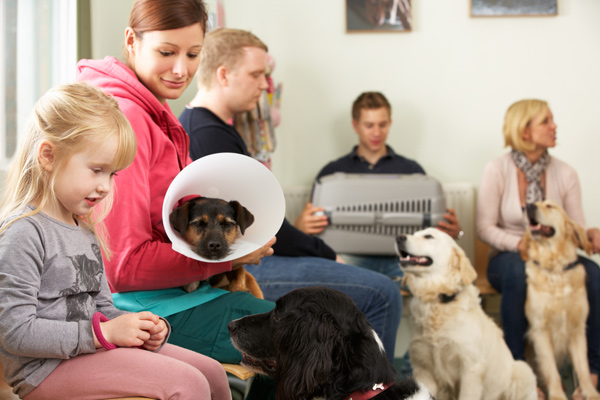6 Waiting Room Tips for Pet Owners
Whether we’re talking about your pet or the one camped in the owner’s lap next to you, there are ways to improve everyone’s waiting room experience. Because let’s face it, most pets don’t enjoy their time there — and by extension, plenty of their people don’t either.
It’s true; though they may tolerate us well enough, the majority of pets would prefer to be at the park or curled up in a sunny spot than in a busy hospital’s waiting room. But it doesn’t have to be terribly stressful either. To that end, here are some stress-relieving, enjoyment-enhancing waiting room to-dos for your consideration.
 DO: Ditch that flexible leash in favor of a gloriously short one. Ever seen anyone get hog-tied by someone’s too-long leash? I have. It’s not pretty.
DO: Ditch that flexible leash in favor of a gloriously short one. Ever seen anyone get hog-tied by someone’s too-long leash? I have. It’s not pretty.I’ve said it before: Flexible-length leashes are the bane of my existence, especially in a veterinary hospital. Now if everyone knew how to use one and paid attention to its setting… that would be different. A short leash, on the other hand, is everyone’s friend in the waiting room.
DO: Use the right kitty carrier. Transportation to the clinic can be stressful for any pet, but once in the waiting room, the wrong carrier can become another source of anxiety. Soft-sided, dark-screened and cozy carriers are way better than roomy, plastic- or wire-mesh-sided crates with lots of windows (however, even those are better than no carrier at all).
Keep your cats cozily hidden — not only are they happier that way, but the dogs with high prey drives don’t all go nuts watching the kitties hiss back at them.
DO: Ask before letting dogs meet and greet. Some dogs simply do not appreciate canine attention. Not all dogs are well socialized to other dogs, after all. If you want your dog to interact, always ask the other dog’s owner if it’s OK first.
Note: If your dog resents the exuberance of pups or simply does not appreciate being sniffed or interacted with, let others know. It’s your job to protect him from others’ well-intentioned naiveté.
DO: Pay attention to the waiting room’s activities. Not only is it entertaining to watch the goings-on of any vet hospital lobby, it’s useful, too. How else will you know if things are heating up between your dog and another or if someone’s just walked in with a loose cat (it happens!). Remember, animals will be animals.
DO: Take steps to mitigate stress. Getting cats into carriers and getting dogs into cars can be stressful. We know this. That’s why we recommend you take certain steps to make things simpler.
Start with desensitization. Some smart cat owners leave the carrier out all the time in a high cat-traffic area and leave the door open so cats can venture in and out. Others will use the carrier for fun stuff (like feeding them or as a catnip playtime spot), so cats associate positive things with the carrier. Taking dogs for rides in the car (safely buckled in or secured in a carrier) can also go a long way toward desensitizing them to the stresses of transport.
Some cats also respond well to the use of Feliway, a relaxing pheromone you can spray inside the carrier or use as a diffuser in your house the day you have a veterinary appointment. Dogs, for their part, can sometimes do well to sniff a little lavender oil on their bandanas or a towel in the car. A pheromone-infused collar (called Adaptil) can be helpful for some, too.
DO: All of the above, and you’re way more likely to have better vet visits going forward.
Source: Vet Street




Comments
Post a Comment